As the J1 League approaches the halfway point of its season, Vissel Kobe currently occupy the summit of Japan’s top division. Level on points with Yokohama F Marinos, but having played a game less, Vissel’s rapid rise has been propelled by head coach Takayuki Yoshida.
The Ushi have won 10 out of their 15 league matches so far this season, having finished the 2022 season in 13th position with just a single win more than they have already amassed this season. Incredibly, nine of those 11 wins were overseen by Yoshida who only took over for the second half of the season.
This tactical analysis piece will analyse how Yoshida, appointed head coach of a side with just two wins at this stage last season, has brought Vissel back to winning ways. This tactical analysis will take the form of a scout report and focus on a key element of Vissel’s attacking tactics, creating triangles and overloads in wide areas. This analysis will also dissect one of their recent cunning corner-kick routines.
Vissel Kobe’s set-up and stats
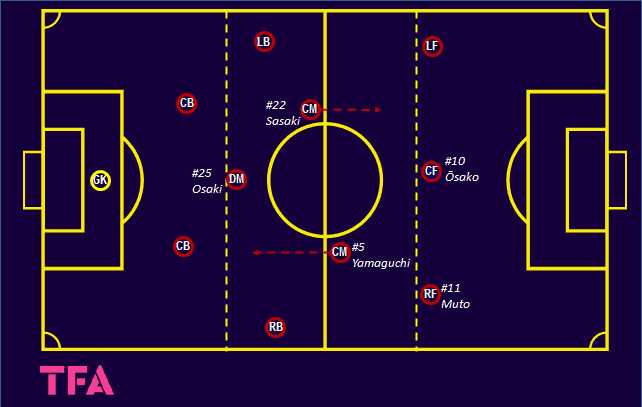
Vissel have consistently used a variation of 4-3-3/4-2-3-1 this season. The only exception to this has been in their previous match, a J-League league cup match against Nagoya Grampus, where Yoshida completely changed his lineup and switched to a 3-5-2.
Several players in central midfield have been utilised this season. The most common combination in recent league matches has been #5 Hotaru Yamaguchi, #22 Daiju Sasaki and #25 Leo Osaki. Yamaguchi has played on the right of the three, with Sasaki on the left. Sasaki plays deeper than Yamaguchi, almost as a second defensive midfielder, with Sasaki almost playing as a number ’10’ but usually only on the left side of the pitch. Osaki plays the most centrally as a defensive midfielder.
Barcelona legend and four-time UEFA Champions League winner Andrés Iniesta is still with the club but has only featured briefly in three league games this season. The former La Liga star is due to bring to an end his time in Japan next month but his influence on the midfielders he leaves behind will remain.
#10 Yūya Ōsako and #11 Yoshinori Muto are the most effective players in the team in terms of goal contributions. Both sit joint second in the J1-League with 13 goals and an assist apiece, one contribution behind Yokohama F Marinos’ Brazilian forward Anderson Lopez.
Central forward Ōsako is the team and league’s top goalscorer with 11 goals. The 182cm tall forward has scored three of his previous five goals from headers. Muto, who plays at right-forward, has seven assists in 15 games this season and tops the league’s assists chart.
Wide-area triangles
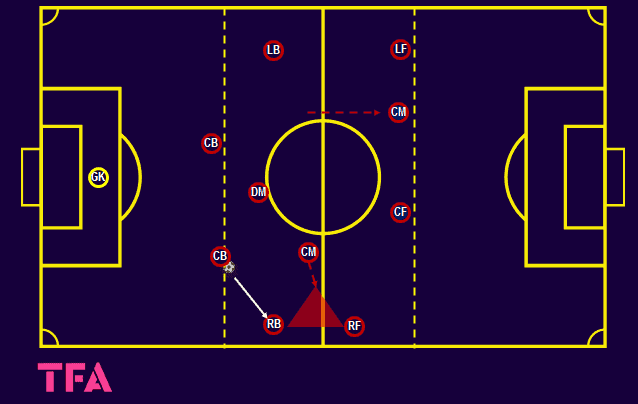
A key part of Vissel’s attacking threat comes from overloads in wide areas. In the final third, these overloads are used to create crossing or cut-back opportunities in which midfielders and forwards flood into the box to attack. From deeper areas, the aim is often to draw opposition players to one side before switching the play and creating one-on-one situations on the opposite side.
As the above tactical diagram shows, Vissel’s initial set-up of these overloads is done by creating a triangle in the wide area. The triangle is comprised of the full-back, wide-forward and the ball-near central-midfielder, who makes his supporting movement as the ball is travelling wide.
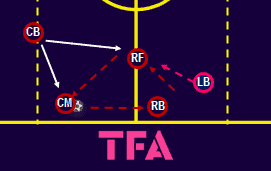
The wide-forward or full-back receives the ball whilst the two players are no more than 10 to 15 yards apart. This distance allows them to link up and for the triangle to perform different rotations. For example, as shown above, the central midfielder can move into the wide area as the wide-forward drops into the half-space. This can either lead to the wide-forward receiving alone in the half-space or, if the opposition full-back jumps, allow the full-back to run in behind.
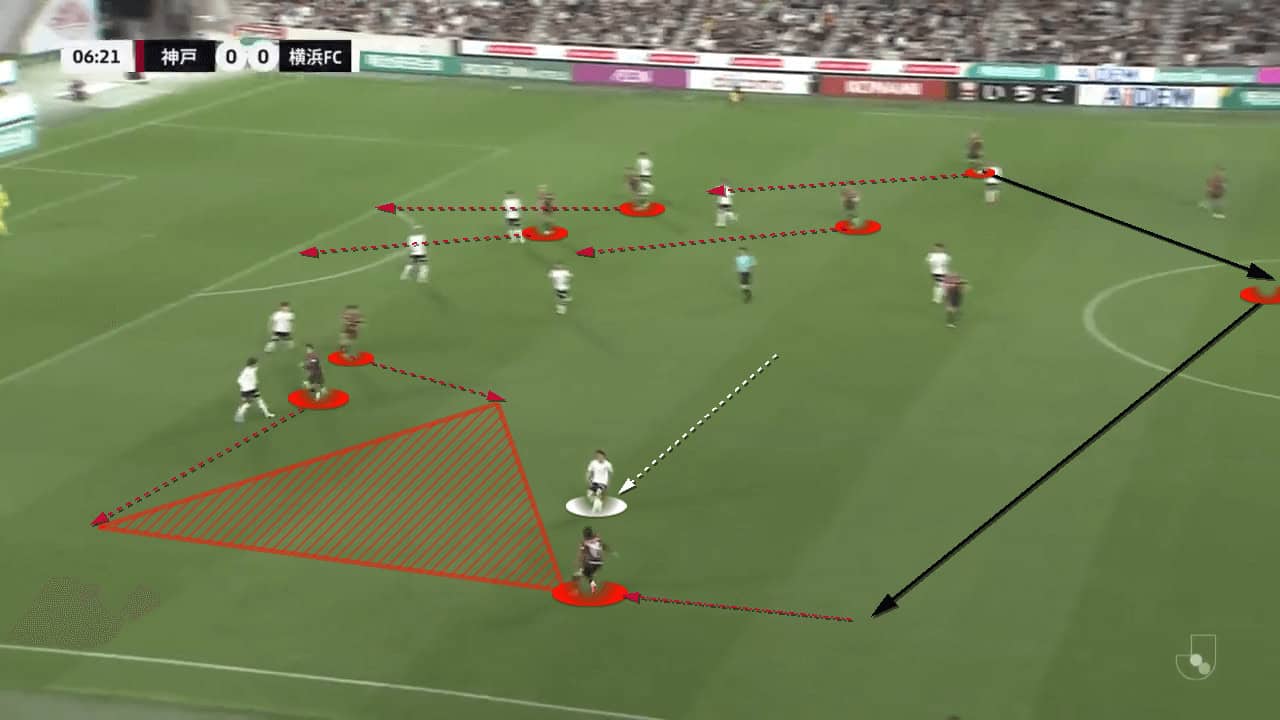
The above image, from Vissel’s match against Yokohama FC, shows Vissel attacking down their left from a switch-of-play. In this example, and as shown on the first tactical diagram, the ball-far central-midfielder stayed away from the ball and pushed onto the opposition’s centre-back. The left-forward stayed high and wide, occupying the right wing-back.
The opposition’s midfield shifted to Vissel’s right side to defend the initial overload. The left-sided central-midfielder and left-forward remaining high, on the ball-far side, means they are now pinning the opposition’s right wing-back and side centre-back.
The positioning of the midfielder and forward allows Vissel’s left-back, #19 Ryo Hatsuse, to receive alone. Hatsuse, who had picked up a slightly inverted position, backtracked into the wide area as the ball was passed back to his ball-far centre-back. As he received the ball, he took an aggressive first touch and attacked the space ahead of him.
Now, as Hatsuse is being closed down by the opposition’s widest midfielder, and can no longer progress by dribbling, they reform a triangle. This three-on-three allowed the attacking players to pull the opposition out of position and create space for a cross.
Wide-area overloads in the build-up
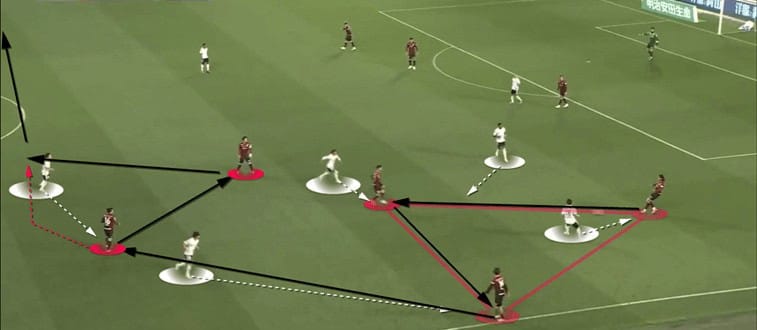
In this example, which led to a goal against F Marinos, Vissel created a triangle in their defensive third in the same manner as described previously. As the left-back was about to receive the ball from his centre-back, the left-sided central midfielder ran towards the ball to create a triangle with the left-back and left-forward.
On this occasion, with the ball in their defensive third, the right-sided midfielder #5 Yamaguchi stayed low and close to his defensive midfielder. Yamaguchi and the left-sided central midfielder then further overloaded the area, bringing more opposition players with them.
These movements in total baited five opposition players to press the ball leaving them weak on the far side. The five Vissel players around the ball combined in the sequence shown above to escape the opposition’s press and break out to attack down the right.
Every pass was received, and played, in the direction the player was facing. This perfect body orientation, combined with positioning, allowed each player to see where the ball was coming from and their next passing option. The outcome was like a pinball machine with the ball almost bouncing from each player to the next, with the opposition unable to get anywhere near the ball.
During this build-up, the right forward, Muto, remained high and wide in the opposite wide area. When the ball was worked to his side, he was one-on-one with the opposition’s left-back.
Cunning corner routine
Vissel’s typical corner routines this season can be characterised by crowding the box and performing basic screens to allow their key target players to get on the end of crosses. Although often an effective strategy, they are not the most creative of corner kick routines.
However, Vissel’s most recent match, a league cup match against Nagoya Grampus, saw them veer from their usual approach. In their first corner of the match, they carried out something a little more creative, which caught their opponents off guard.
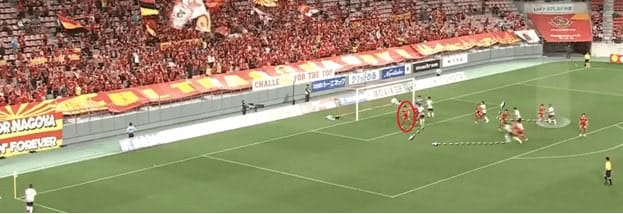
Vissel’s initial set-up was very similar to how they have been setting up for corners in recent matches. This helped disguise their intentions. Two players were positioned in the six-yard box, one on the goalkeeper with the other initially on the goalkeeper before moving off him as the ball was about to be delivered.
The player that moved off the goalkeeper then performed a (what turned out to be a fake) screen on the opposition’s first zonal defender (circled). As he blocked the first defender, his teammate, initially positioned on the edge of the box, made a dashing run to the front area.
The other three players in the box all made runs to attack the six-yard box. They brought their markers with them and emptied the second six-yard box. The furthest player from the ball (highlighted) then pushed off his marker who was goal-side and backtracked to the corner of the six-yard box.
All six players in the box’s initial actions make it look as though the ball was going to be delivered to the front area. However, it was the highlighted player at the back area who was the target.

The target player’s outstretched arms, pushing against the back of his marker, created enough separation for him to win his header. The three players that had corralled their markers into the goal area then screened the defenders to protect the headed knockdown.
As the cross drifted over the player who performed the front area screen (highlighted), he acted uninterested. Only as the target man was about to head the ball back across the goal did he come alive again. He darted into the middle of the second six-yard box and found himself alone with a clear shot at goal.
Conclusion
In addition to the tactics analysed above, Yoshida’s game model is based on energetic pressing and counterattacks. He has a clear, high-intensity approach to football. A style that he does not compromise even for players as highly esteemed as the departing Iniesta. The effectiveness is clear to see, both in performances and in the results. Yoshida has turned the ship and Vissel are sailing in the right direction.
With Vissel, last year’s J1 league champions F Marinos, and Nagoya all separated by just a single point, the championship looks like it will go down to the wire. Vissel’s trajectory under Yoshida suggests it could be them that lift the trophy in December.






Comments